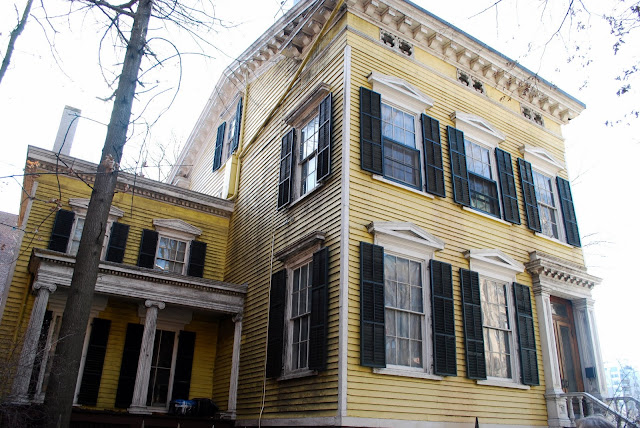As I wrote in
my last blog post, two friends and I are beginning to follow walking tours in the book
"Walking Brooklyn: 30 tours exploring historical legacies, neighborhood culture, side streets and waterways." by Adrienne Onofri. The first tour we decided to follow was a one and three-quarter-mile walk of the
Clinton Hill neighborhood, bounded by Classon Avenue, Willoughby Avenue, Vanderbilt Avenue, and Gates Avenue. In the late 19th century this neighborhood was one of the most prestigious addresses in Brooklyn, after Brooklyn Heights. Charles Pratt, Brooklyn's wealthiest resident at the time, a partner in Standard Oil with the J.D. Rockefeller, and a local philanthropist, built his mansion in 1875. A number of Pratt's fellow tycoons, such as Pfizer, Bristol, and Liebmann (owner of the Reingold brewery) followed Pratt to "The Hill." Pratt's biggest construction project was
Pratt Institute, which I profiled in my last post. Pratt's Higgins Hall is seen above.
The
New York Police Department's 88th Precinct is housed in this unique 1890 brick building with a high conical tower. It was designed by George Ingram, the Assistant Engineer for the Brooklyn Department of City Works, in the mid-1880s, when he undertook to design the basic framework for new precinct houses in Brooklyn. The 88th Precinct (once called the 4th precinct) building remains one of his most visible designs still in use today.
The Convent of the
Sisters of Mercy has maintained a presence in Brooklyn since 1855. At one time it housed both nuns and orphans who were under their care. The facility was in need of extensive repairs, so the sisters sold the property and it is undergoing a conversion to an office building. This
New York Times article tells the poignant story about the last nuns to leave the property. It will continue to house the
Dorothy Bennett Mercy Center, a program that offers educational opportunities for the youth and elderly of the community.
Emmanuel Baptist Church, located at 279 Lafayette Avenue, was built in 1887 by Charles Pratt, a devout Baptist. It has one of New York's most spectacular church interiors, a rich mixture of stained glass, wood and elaborate stencil work, but unfortunately, they do lot allow photography inside.
.
The large building at 320 Washington Avenue is still inscribed "Graham Home For Ladies" The home was founded in 1851 by John Graham, Esq. He donated this beautiful plot of ground upon which was built this noble 5 story brick building in the Greek Revival / Italianate style. It operated for over a century, but after it closed the building deteriorated into a "fleabag" hotel. Now that this neighborhood has become gentrified again, this building has been rehabilitated into
expensive luxury condos.
A public playground and park are next door on Washington Street and Lafayette called
Underwood Park, named for the typewriter mogul, John Thomas Underwood (1857-1937), whose mansion once stood on this property.
Waverly Avenue held the carriage houses and stables for the wealthy, and many of these buildings have been converted into homes and private garages.
The Charles Pratt House at 232 Clinton Avenue, that was built in 1874, is a freestanding example of the transitional Italianate/neo-Greco style dwelling. It is now the Founders Hall of
Saint Joseph's College. Pratt also had mansions built directly across the street for his three sons as wedding presents.
The house on the left in the collage above, 241 Clinton Ave, was built by Pratt in 1890 for his son, Charles Millard Pratt. It is now the residence of
Brooklyn's Roman Catholic Bishop Nicholas DiMarzio. The house in the upper right, at 229 Clinton Ave, is the Frederick B. Pratt home, now called the Caroline Ladd Pratt House. The house in the lower right, at 245 Clinton Ave., was the home of George Dupont Pratt, and built in 1901. It is now part of Saint Joseph's College.
This beautiful classic Gothic Revival villa, at 284 Clinton Ave., is a rare gem. It was the former William W. Crane House and was built in 1854.
Right next door at 278 Clinton Ave is a Queen Anne house, with Neo-Greco elements, circa 1884.
These two-century-old structures that stand side by side are, on the left, the
Brooklyn Masonic Temple
, at 317 Clermont Ave, assembled in 1908 by two architectural firms, Lord and Hewlett and Pell and Corbett, as a replica of King Solomon's Temple. Only two other temples of this kind have been erected; one in Colorado and one in Egypt. Next to it, with the address of 300 Vanderbilt Ave., is the very ornate
Queen of All Saints Church, was built in 1911
.
The left side portion of this yellow clapboard house, located at 200 Lafayette Ave., was built in 1812. The rest was added on in the 1850s. It is one of the oldest houses in Brooklyn. It is variously known as the Joseph Steele or the Steele-Brick-Skinner House, for its various past owners. It was built when Brooklyn was basically farmland with a few suburban villas. The Steele House is prized for being the largest and best remaining example of a wooden suburban mansion in the transitional Greek Revival/Italianate style now standing in any of the five boroughs.
Clinton Hill also contains many blocks of beautiful brownstones....
...and many other outstanding homes of all styles of architecture.
My friends and I really enjoyed our walk and learning more about the history and architecture of the Clinton Hill neighborhood of Brooklyn. We look forward to our next neighborhood walk this week!
 Pin It
Pin It







































































